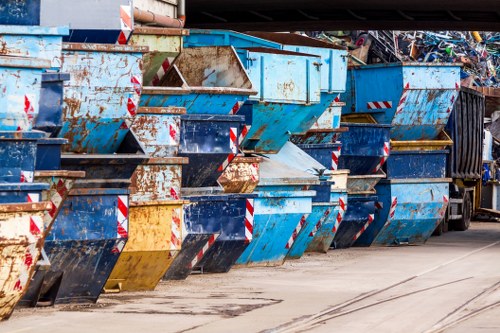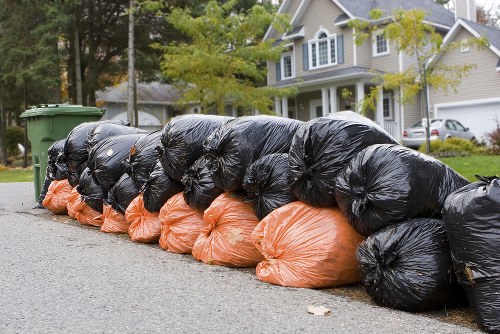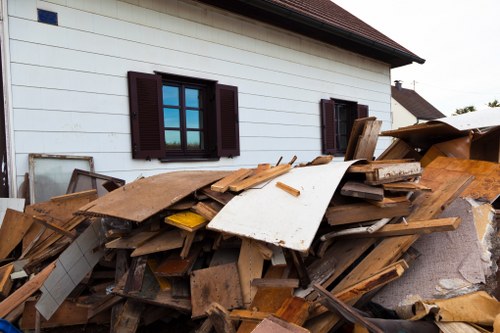Waste Disposal in Sofa Removals
Introduction to Sofa Removal Waste Disposal

Sofa removals are a common necessity, whether you're upgrading your living space or decluttering your home. However, the process of removing a sofa isn't just about transportation; it also involves proper waste disposal to ensure environmental sustainability and compliance with local regulations.
Understanding the intricacies of waste disposal in sofa removals can help homeowners and businesses alike manage their furniture removal more efficiently and responsibly.
In this article, we'll delve into the various aspects of sofa removal waste disposal, including methods, regulations, and best practices to minimize environmental impact.
Why Proper Waste Disposal Matters

Proper waste disposal is crucial for several reasons:
- Environmental Protection: Prevents harmful materials from polluting land and water.
- Legal Compliance: Adheres to local waste management regulations.
- Health and Safety: Reduces risks associated with improper waste handling.
Neglecting proper disposal can lead to severe consequences, including fines, environmental degradation, and health hazards.
Therefore, integrating effective waste disposal strategies into sofa removals is essential for sustainable living.
Types of Sofa Waste

Sofas can become waste in various forms, each requiring different disposal methods:
- Recyclable Materials: Metal frames, wooden components, and certain textiles can be recycled.
- Non-Recyclable Materials: Upholstery with mixed or non-recyclable fabrics.
- Hazardous Components: Foam padding or chemical treatments used in some sofas.
Identifying the type of waste helps determine the appropriate disposal or recycling method.
Moreover, separating recyclable and non-recyclable parts can significantly reduce the environmental footprint of sofa removals.
Disposal Methods for Removed Sofas

There are several methods available for disposing of sofas after removal:
- Donation: If the sofa is still in good condition, donating it can extend its life and benefit those in need.
- Recycling: Breaking down the sofa into recyclable components helps reduce waste.
- Landfill Disposal: As a last resort, disposing of sofas in landfills is possible but not environmentally friendly.
- Professional Removal Services: Hiring services that specialize in eco-friendly disposal ensures proper handling.
Each method has its pros and cons, and the best choice depends on the sofa's condition and local disposal facilities.
Engaging in responsible disposal practices contributes to a greener environment.
Regulations and Compliance

Waste disposal is governed by various local, state, and federal regulations aimed at protecting the environment and public health.
Key regulatory considerations include:
- Licensing: Ensuring that disposal services are licensed and follow legal guidelines.
- Waste Classification: Properly categorizing waste to determine the appropriate disposal method.
- Reporting: Maintaining records of disposed items as required by law.
Non-compliance with these regulations can result in hefty fines and legal issues.
Staying informed about local laws and working with compliant removal services is essential.
Best Practices for Sustainable Sofa Removal
Adopting best practices can make sofa removals more sustainable and reduce waste:
- Assess Sofa Condition: Determine if the sofa can be reused, donated, or recycled.
- Choose Eco-Friendly Removal Services: Select companies committed to sustainable practices.
- Separate Materials: Dismantle the sofa to separate recyclable and non-recyclable parts.
- Promote Reuse: Encourage donating sofas in good condition to extend their lifecycle.
Implementing these practices contributes to environmental conservation and efficient waste management.
Moreover, it fosters a culture of responsibility and sustainability in furniture disposal.
Recycling Processes for Sofa Components
Recycling sofas involves breaking them down into individual components:
- Frame Recycling: Metal or wooden frames are separated and processed for recycling.
- Upholstery Recycling: Textiles are sorted; fabrics can be recycled or repurposed.
- Foam and Padding: Foam materials are processed for reuse or recycling where facilities are available.
Each component requires specific processing techniques to ensure effective recycling.
By recycling individual parts, the overall environmental impact of sofa disposal is minimized.
Environmental Benefits of Proper Disposal
Proper waste disposal during sofa removals offers numerous environmental benefits:
- Reduced Landfill Use: Decreases the volume of waste sent to landfills.
- Conservation of Resources: Recycling conserves natural resources by reusing materials.
- Lower Carbon Footprint: Reduces greenhouse gas emissions associated with manufacturing new products.
- Prevention of Pollution: Avoids contamination of soil and water from improperly disposed sofas.
These benefits highlight the importance of responsible waste disposal practices.
Adopting sustainable disposal methods contributes to a healthier planet for future generations.
Choosing the Right Removal Service
[p class="cta"] Contact us today to ensure your sofa removal is handled responsibly and sustainably.Selecting a reputable removal service is crucial for effective waste disposal:
- Experience: Look for services with a proven track record in eco-friendly disposal.
- Certifications: Ensure the company complies with relevant environmental regulations.
- Recycling Policies: Choose services that prioritize recycling and reuse of materials.
- Customer Reviews: Positive feedback indicates reliable and sustainable practices.
Investing in the right removal service ensures that your sofa disposal aligns with environmental and legal standards.
Moreover, it provides peace of mind knowing that your waste is managed responsibly.
Cost Considerations
Waste disposal costs can vary based on several factors:
- Sofa Condition: Reusable or recyclable sofas may incur lower disposal costs.
- Removal Service: Eco-friendly services might have different pricing structures.
- Volume of Waste: Larger or multiple sofas can increase disposal expenses.
- Local Regulations: Compliance with local laws can affect overall costs.
Understanding these factors helps in budgeting for sofa removals.
It's essential to balance cost with the environmental impact to make informed disposal decisions.
Innovative Disposal Solutions
Advancements in waste management offer innovative solutions for sofa disposal:
- Upcycling: Transforming old sofas into new products or art.
- Modular Design: Sofas designed for easy disassembly and recycling.
- Biodegradable Materials: Using eco-friendly materials that decompose naturally.
- Technology Integration: Utilizing software to optimize waste sorting and recycling processes.
These innovations enhance the efficiency and sustainability of sofa removal waste disposal.
Embracing new technologies and designs can significantly reduce the environmental impact of furniture disposal.
Case Studies and Success Stories
Examining successful sofa disposal initiatives provides valuable insights:
- Community Donation Programs: Local organizations collect and redistribute used sofas to those in need.
- Corporate Recycling Efforts: Businesses implement comprehensive recycling programs for office furniture.
- Innovative Startups: Companies developing technologies for efficient furniture recycling.
These case studies demonstrate the feasibility and benefits of proper waste disposal in sofa removals.
They also inspire others to adopt sustainable practices in their disposal processes.
Challenges in Waste Disposal
Despite the benefits, several challenges persist in sofa removal waste disposal:
- Lack of Awareness: Many are unaware of proper disposal methods.
- Limited Recycling Facilities: Not all areas have access to comprehensive recycling services.
- Cost Barriers: Sustainable disposal options can be more expensive.
- Complex Material Composition: Mixed materials in sofas complicate recycling efforts.
Addressing these challenges is essential for improving waste disposal practices.
Education, infrastructure development, and policy support can mitigate these issues.
Future Trends in Sofa Disposal
The future of waste disposal in sofa removals is poised for significant advancements:
- Circular Economy Models: Designing sofas with end-of-life disposal in mind.
- Advanced Recycling Technologies: Improving the efficiency and scope of material recycling.
- Sustainable Manufacturing: Using eco-friendly materials and processes in sofa production.
- Increased Legislation: Stricter laws promoting responsible waste management.
These trends indicate a move towards more sustainable and efficient disposal methods.
Embracing these changes can lead to significant environmental and economic benefits.
Conclusion
Waste disposal in sofa removals is a critical aspect of responsible living and environmental stewardship.
By understanding the types of waste, disposal methods, regulations, and best practices, individuals and businesses can manage sofa removals effectively.
Choosing sustainable disposal options not only protects the environment but also aligns with growing societal expectations for responsible waste management.
Contact us today to ensure your sofa removal process is handled with care and sustainability in mind.